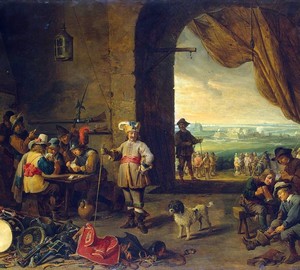
Description of the picture:
Guardhouse – David Teniers the Younger. 1642. Oil on wood. 69×103
David Teniers the Younger created the “Sentry” in 1642, when “the new ruler of the Spanish Netherlands Francisco de Melo twice defeated the French troops, which allowed for a short time to deflect the blow from Antwerp” (Klinge 1991). The battle depicted in the background is perhaps a peculiar echo of these events. Based on these historical facts, Klinge (1991) believed that the Hermitage work contains three (basic elements (military still life; characters of the genre scene; landscape background with figures) expressing the general idea of military power, protecting the country and the Scheldt River. Along with the historical background the Flemish artist introduces a theatrical element into the traditional plot of Karaulni. Thanks to the richness and richness of bright colors, the Teniers painting makes a festive impression. The stage is occupied by a luxurious still life of knightly armor, flags, attributes in music (drum, trumpet, timpani) and weapons.The central place in the picture is given to the head of the guard in an elegant suit, standing in a spectacular pose This figure ties together the characters of the second plan (in the left and right parts) and at the same time gives the eye the opportunity to penetrate through the arch.The curtain hanging here accentuates theatrical note even more, it rises, revealing a landscape view and additional “scenic” space. The panoramic landscape includes an episode of the siege of the fortress by a military detachment.
Almost all the authors are unanimous in their assessment of the Hermitage’s “Guardhouse”, recognizing the picture as one of the best among Teniers’s numerous works on this subject."